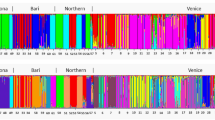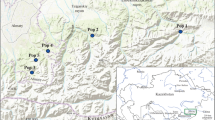Abstract
This paper describes our investigation of genetic variation and clonal structure of the Mediterranean moss Pleurochaete squarrosa (Brid.) Lindb. (Pottiaceae), using inter-simple sequence repeat (ISSR) molecular markers and trnLUAA (intron of plastid gene for Leu tRNA) sequence, choosing different sampling strategies and scales on 16 European populations. Moreover, the intercontinental distribution of two trnL haplotypes, previously found over a large area and including 24 populations in three continents, was also investigated. Despite the prevalent asexual reproduction, P. squarrosa shows a high level of genetic diversity. Some site features seem to affect the clonal structure at the local scale, influencing the relocation of detached fragments and the level of intermingling, but they do not substantially affect genetic diversity. The peculiar vegetative reproduction coupled with somatic mutation could partly account for the genetic variation detected. Genetic distances highlight geographic isolation and limited gene flow among populations. We found only two trnL haplotypes in Europe due to length polymorphism, but, over an intercontinental scale, only non-delete trnL was found in Africa and the USA. ISSR analysis within each population detected a higher genetic distance between the samples with different trnL haplotypes, suggesting the presence of two different genetic lineages within this species, geographically overlapping in the Mediterranean Basin.





Similar content being viewed by others
References
Agapow PM, Burt A (2001) Indices of multilocus linkage disequilibrium. Mol Ecol Notes 1:101–102
Avise JC (2002) Phylogeography, the history of and formation of species. Harvard University Press, Cambridge, Massachusetts
Chiang TY, Schaal BA (1999) Phylogeography of North American populations of the moss species Hylocomium splendens based on the nucleotide sequence of internal transcribed spacer 2 of nuclear ribosomal DNA. Mol Ecol 8:1037–1042
Cronberg N, Rydgren K, Økland RH (2006) Clonal structure and genet-level sex ratios suggest different roles of vegetative and sexual reproduction in the clonal moss Hylocomium splendens. Ecography 29:95–103
During HJ (1992) Ecological classification of bryophytes and lichens in a changing environment. Clarendon Press, Oxford, pp 1–31
Excoffier L, Smouse P, Quattro J (1992) Analysis of molecular variance inferred from metric distances among DNA haplotypes: application to human mitochondrial DNA restriction data. Genetics 131:479–491
Excoffier L, Laval G, Schneider S (2006) Arlequin ver 3.1. An integrated software package for population genetics data analysis. Computational and Molecular Population Genetics Lab. University of Berne, Switzerland
Fernandez CC, Shevock JR, Glazer AN, Thompson JN (2006) Cryptic species within the cosmopolitan desiccation-tolerant moss Grimmia laevigata. PNAS 103:637–642
Fernández-Mendoza F, Estébanez B, Gómez-Sanz D, Ron E (2002) Sporophyte bearing specimens of Pleurochaete squarrosa in Zamora, Spain. Cryptog Bryol 23:211–215
Giordano S, Alfano F, Esposito A, Spagnuolo V, Basile A, Castaldo Cobianchi R (1996) Regeneration from detached leaves of Pleurochaete squarrosa (Brid.) Lindb. in culture and in the wild. J Bryol 19:219–227
Grundmann M, Schneider H, Russell SJ, Vogel JC (2006) Phylogenetic relationships of the moss genus Pleurochaete Lindb. (Bryales: Pottiaceae) based on chloroplast and nuclear genomic markers. Organ Divers Evol 6:33–45
Grundmann M, Ansell SW, Russel SJ, Koch MA, Vogel JC (2007) Genetic structure of the widespread and common Mediterranean bryophyte Pleurochaete squarrosa (Brid.) Lindb. (Pottiaceae)—evidence from nuclear and plastidic DNA sequence variation and allozymes. Mol Ecol 16:709–722
Grundmann M, Ansell SW, Russel SJ, Koch MA, Vogel JC (2008) Hot spot of diversity in a clonal world—the Mediterranean Pleurochaete squarrosa in Central Europe. Mol Ecol 17:825–838
Hassel K, Såstad SM, Gunnarsson U, Söderström L (2005) Genetic variation and structure in the expanding moss Pogonatum dentatum (Polytrichaceae) in its area of origin and in a recently colonized area. Am J Bot 92:1684–1690
Hedderson TA, Nowell TL (2006) Phylogeography of Homalothecium sericeum (Hedw.) Br. Eur.; toward a reconstruction of glacial survival and postglacial migration. J Bryol 28:283–292
Heinken T, Lees R, Raudnitschka D, Runge S (2001) Epizoochorous dispersal of bryophyte stem fragments by roe deer (Capreolus capreolus) and wild boar (Sus scrofa). J Bryol 23:293–300
Hewitt G (1999) Post-glacial re-colonization of European biota. Biol J Linn Soc 68:87–112
Hewitt G (2000) The genetic legacy of the Quaternary ice ages. Nature 405:907–913
Hewitt G (2004) Genetic consequences of climatic oscillations in the Quaternary. Phil Trans R Soc Lond B 359:183–195
Jaccard P (1901) Étude comparative de la distribution florale dans une portion des Alpes et des Jura. Bull Soc Vaudoise Sci Nat 37:547–579
Korpelainen H, Laitinen R, Pohjamo M (2004) Lack of intraspecific variation in cpDNA in Trichocolea tomentella. J Bryol 26:221–222
McDaniel SF, Shaw JA (2003) Phylogeographic structure and cryptic speciation in the trans-Antarctic moss Pyrrhobryum mnioides. Evolution 57:205–215
Miles CJ, Longton RE (1992) Deposition of moss spores in relation to distance from parent gametophytes. J Bryol 17:355–368
Murray MG, Thompson WF (1980) Rapid isolation of high molecular weight plant DNA. Nucl Acid Res 8:4321–4326
Nei M (1972) Genetic distance between populations. Am Nat 106:283–292
Nei M (1987) Molecular evolutionary genetics. Columbia University Press, New York, NY
Peakall R, Smouse PE (2006) GENALEX 6: genetic analysis in Excel. Population genetic software for teaching and research. Mol Ecol Notes 6:288–295
Petit RJ, Aguinagalde I, de Bealuiei JL, Bittkau C, Brewer S, Cheddadi R, Ennos R, Fineschi S, Grivet D, Lascoux M, Mohatny A, Müller-Starck G, Demesure-Musch B, Palmé A, Martin JP, Rendell S, Vendramin GG (2003) Glacial refugia: hotspots but not melting pots of genetic diversity. Science 300:1563–1565
Podani J (2001) Syn-Tax 2000. Computer program for data analysis in ecology and systematics. Scientia Publishing, Budapest, Hungary
Rydgren K, Cronberg N, Økland RH (2006) Factors influencing reproductive success in the clonal moss, Hylocomium splendens. Oecologia 147:445–454
Saitou N, Nei M (1987) The neighbor-joining method: a new method for reconstructing phylogenetic trees. Mol Biol Evol 4:406–425
Shaw AJ (1990) Interclonal variation in morphology, growth rate and copper tolerance in the moss Funaria hygrometrica. Evolution 44:441–447
Shaw AJ (2000a) Molecular phylogeography and cryptic speciation in the mosses Mielichhoferia elongata and M. mielichhoferiana (Bryaceae). Mol Ecol 9:595–608
Shaw AJ (2000b) Population ecology, population genetics, and microevolution. In: Shaw AJ, Goffinet B (eds) Bryophyte biology. Cambridge University Press, Cambridge, pp 369–402
Shaw AJ (2001) Biogeographic patterns and cryptic speciation in bryophytes. J Biogeogr 28:253–261
Shaw AJ, Lickey EB, Beck JT, Farmer SB, Liu W, Miller J, Siripun KC, Winder CT, Schilling EE, Small RL (2004) The tortoise and the hare II: relative utility of 21 noncoding chloroplast DNA sequences for phylogenetic analysis. Am J Bot 91:142–166
Skotnicki ML, Ninham JA, Selkirk PM (2000) Genetic diversity, mutagenesis and dispersal of Antarctic mosses—a review of progress with molecular studies. Antarct Sci 12:363–373
Slatkin M (1987) Gene flow and geographical structure of populations. Science 236:787–792
Spagnuolo V, Muscariello L, Cozzolino S, Castaldo Cobianchi R, Giordano S (2007) Ubiquitous genetic diversity in ISSR markers between and within populations of the asexually producing moss Pleurochaete squarrosa. Plant Ecol 188:91–101
Stenøien HK, Såstad SM (1999) Genetic structure in three haploid peat mosses (Sphagnum). Heredity 82:391–400
Taberlet P, Fumagalli L, Wust-Saucy A-G, Cosson J (1998) Comparative phylogeography and postglacial colonization routes in Europe. Mol Ecol 7:453–464
Thompson JD (2005) Plant evolution in the Mediterranean. Oxford University Press, Oxford
Thompson JD, Higgins DG, Gibson TJ (1994) CLUSTAL W: improving the sensitivity of progressive multiple sequence alignment through sequence weighting, position specific gap penalties and weight matrix choice. Nucl Acid Res 22:4673–4680
Van der Velde M, Bijlsma R (2003) Phylogeography of five Polytrichum species within Europe. Biol J Linn Soc 78:203–213
Van der Velde M, Van de Zande L, Bijlsma R (2001) Genetic structure of Polytrichum formosum in relation to the breeding system as revealed by microsatellites. J Evol Biol 14:288–295
van Groenendael JM, Klimeš L, Klimešová J, Hendriks RJJ (1996) Comparative ecology of clonal plants. Phil Trans R Soc Lond B 351:1331–1339
Vogel JC, Rumsey FJ, Schneller J, Barrett JA, Gibby M (1999) Where are the glacial refugia in Europe? Evidence from pteridophytes. Biol J Linn Soc 66:23–37
Wyatt R (1994) Population genetics of bryophytes in relation to their reproductive biology. J Hattori Bot Lab 76:147–157
Acknowledgements
We would like to thank Blanka Shaw and Jonathan Shaw for kindly providing several moss samples from the Duke University Herbarium.
Author information
Authors and Affiliations
Corresponding author
Rights and permissions
About this article
Cite this article
Spagnuolo, V., Terracciano, S. & Giordano, S. Clonal diversity and geographic structure in Pleurochaete squarrosa (Pottiaceae): different sampling scale approach. J Plant Res 122, 161–170 (2009). https://doi.org/10.1007/s10265-008-0206-4
Received:
Accepted:
Published:
Issue Date:
DOI: https://doi.org/10.1007/s10265-008-0206-4




